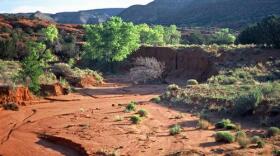Editor's Note: After we published this story, a spokesperson for Kirtland Air Force Base wrote with a series of objections to the story. Kirtland did not allege any factual inaccuracy in our story but we did make a change to reflect that Kirtland's lead discharges into the Rio Grande watershed are not in violation of environmental laws. You can read all of their objections and our responses here.
***
The Pueblo of Isleta is bordered on one side by Kirtland Air Force Base, on another by the City of Albuquerque—and through the middle of the tribe’s ancestral land runs the Rio Grande. The river is the bedrock of the tribe’s cultural heritage. But Pueblo residents say pollution from their bigger neighbors has contaminated the river they consider to be sacred.
Ask a resident of Isleta Pueblo how the tribe’s relationship with the Rio Grande has changed over the years, and you’re likely to hear something like this:
"I grew up drinking water from the river. That’s not a good idea now, in fact we have warning signs not to be in the river."
James Abeita is a pueblo native and tribal councilman who lives on a small farm just west of the Rio Grande about four miles south of Albuquerque. He’s one of many Isleta Pueblo farmers who use water from the river to grow crops like chile, corn and squash.
Water pollution is a consistent worry for farmers here, who find themselves trying to reconcile their belief that the river is sacred with their concerns about contaminants washing downstream.
Government records show that over the past year eight facilities upstream from the tribe have been in violation of the Clean Water Act, the federal law that regulates river pollution. Those violations are for things like releasing undertreated sewage and spilling chlorine into the river.
"It basically takes away the significance of our beliefs because of someone else spoiling the one matter we depend on, and that's the water," Abeita said.
Isleta tribal council members are worried the river pollution could harm people who eat the crops grown in the pueblo. So far, there haven’t been any studies on the subject, so there’s no way to know if people are getting sick.
But Isleta Tribal Council Secretary Verna Teller said pollution in the river has definitely affected another aspect of the tribe’s way of life: the religious ceremonies that take place in the Rio Grande.
"Our ceremonies and our religious culture here in our community are of utmost importance to us," she said. "That’s what’s kept us who we are as a people. And so when there’s any threat to that, it’s very frightening for our people. It’s a threat to our existence as far as we’re concerned."
Teller said at times the Rio Grande has been visibly polluted, to the point that they’ve had to stop using the river water for ceremonies. That’s improved somewhat over the years, but thumbing through a stack of federal environmental reports, she questions how much progress has actually been made.
"These numbers scare me," she said. "It makes me want to cry. I don’t know if we’re going to get this city or even the city of Santa Fe to stop these violations, or at least to mitigate them to some point."
Jeff Romanowski is chief engineer at Albuquerque’s Southside Wastewater Reclamation Plant, where a stream of clear, treated wastewater flows into the muddy Rio Grande not far upstream from Isleta’s border.
Isleta officials have been concerned about the plant’s impact on the river for years. And multiple environmental violations there have only stoked the tribe’s concerns further (check out Public Health New Mexico's interactive timeline of Clean Water Act Violations here).
"Violations are bad in general," Romanowski said.
The water utility is spending hundreds of millions of dollars to overhaul outdated equipment at the plant, and officials there say that will bring them into full compliance with the Clean Water Act.
But the city’s water plant is only one of many nearby sources of pollution that could flow into the Rio Grande, according to the EPA. To name a few: Rio Rancho’s wastewater treatment plant has been in violation of environmental laws for years. The City of Albuquerque has, at times, drained nearly six million times its permitted amount of aluminum into the watershed through stormwater drains, along with lead, PCBs and arsenic. And over the past decade, more than 700 pounds of lead has legally washed into the Rio Grande watershed from Kirtland Air Force Base.
Funding for KUNM's Public Health New Mexico project comes from the McCune Foundation and the W.K. Kellogg Foundation. Find out more at publichealthnm.org.







